Quality AND Quantity All In One Swimming Workout!

Photo Courtesy: Griffin Scott
By Ronald Hehn
Research published in the 1979 article by John Shea et. al. in the Journal of Experimental Psychology: Learning and Memory suggests that motor skills are best acquired through repetition, and retained if practiced in a random and varied order.
Traditional training methods consist of long, repetitive sets; these patterned sets are predictable and lack variation. High-repetition training is a great method for teaching new skills to inexperienced athletes; the method is similar to using ‘times tables’ to teach multiplication during early math education. Conversely, Shea’s 35-year-old research suggests that workouts consisting of randomized and varied sets are the best way for experienced athletes to improve upon and retain pre-existing skills. This workout contains both repetition and variation, thus beneficial to both inexperienced and experienced athletes.
In my opinion, it would be best to teach an inexperienced athlete new motor skills in a lake, ocean, or 50-meter pool via repetition and quantity; experienced athletes would benefit from shorter pools such as diving wells, hotel pools, or the width of an 8- or 6-lane pool via randomization and quality.
This workout requires athletes to complete a given amount of cycles rather than distances. A cycle for butterfly and breaststroke is 1 stroke, while a cycle for freestyle and backstroke is 2 strokes. If the required amount of cycles is performed before completing a length, finish the remaining distance using non-competitive strokes (i.e. kick, drill, or make something up!)
The workout begins with consecutive cycles at high repetitions. It progresses to reduce the amount of consecutive cycles per stroke until the lengths are swum performing different strokes for varying amounts of cycles. The interval should accommodate a large group with a wide variety of ability levels. The final “RANDOM” set should be performed as 10 cycles: 4 of the first stroke, 3 of the second, 2 of the third, and 1 of the final stroke. The strokes cycle in an order that I learned from my experience at Indiana University called “Indiana Style”.
A great way to make this workout more competitive is to have the athletes keep track of their total yardage. Greatest distance-per-stroke wins!
Reference:
“Contextual interference effects on the acquisition, retention, and transfer of a motor skill.”
By Shea, John B.; Morgan, Robyn L.
Journal of Experimental Psychology: Human Learning and Memory, Vol 5(2), Mar 1979, 179-187.
http://psycnet.apa.org/journals/xlm/5/2/179/



